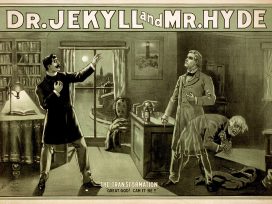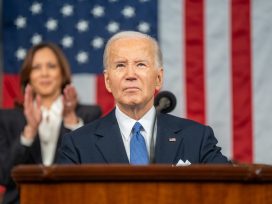It’s a shame that more people didn’t watch Donald Trump give the 2019 State of the Union speech. Whatever else one may say about it, it was one of a kind.
Most remarkable was that it took place at all. The US government had just been shut down for 35 days, the longest in history. The hostility between the parties was so palpable that they could hardly sit in the same room together. The Republican Vice President and the returning Democratic Speaker of the House, both on camera during the whole speech, had a wall of ice between them. Early reports said that the speech would be the President’s attempt to be bipartisan – which would have been a first – while ‘standing firm on his basic principles.’ Clearly such a speech could never be made.
Yet it was, as Trump Republicans cheered at the sound of every catch-phrase, and the group of spirited new Democratic women representatives dressed in suffrage white acted as if they were training for the Olympics. The President changed topics 29 times, which turned out to be a blessing in disguise. As soon as Trump constituents started to get nervous about his conciliatory tone, he’d switch to a trope about the US being the strongest nation in the world; as soon as his anti-socialist, anti-immigrant rants started to drive progressive Democrats up the wall, he’d croon a tribute to the brave survivors of childhood cancer. In a way, it was a bravura performance.

Cosplay at New York Comic Con 2016. Photo source: Wiki commons
The problem is that the speech was dated. Very dated. World War II soldiers and Holocaust survivors waved unsteady hands at an audience that for the most part hadn’t been alive when they were fighting or imprisoned. Virtually nothing pointed to the future: apart from a few tepid proposals like paid maternity leave and lower cost drugs, we were back to the President’s boasts about a booming economy, and the horrific images that he conjured up of savages massing along the southern border.
The real takeaway from the evening is that, wonder of wonders, we’ve gotten used to Donald Trump. Supporters and detractors have learned how to read him. World leaders know when to humour him and when to give him a wide berth. Even his military commanders, agency heads and dissident factions in the party are starting to stand up for themselves; there’s talk of people running against him in the 2020 Republican party primaries.
In terms of his accomplishments, the old-fashioned style of the speech – even its harkening back to the red-baiting of the 1950s – was a pretty accurate reflection of his tenure. The image that best fits the President of the past two years isn’t that of businessman or statesman, but of an old-school Mafia Don: protective of (and deferential to) his immediate family; generous and even tender with those he considers part of his larger family (reformed prisoners, sick people, disabled veterans), hostile to everybody outside his circle of influence (the press, the Democrats, most of the rest of the world).
So in foreign relations, aside from some inconclusive negotiations with North Korea and China, his skills have been best in dismantling rather than innovating. In two years he has left a trail of weakened or broken alliances: the Intermediate Range Nuclear Forces Treaty, the Paris Accords, the Iran Nuclear Agreement, the Trans-Pacific Partnership, the UN Human Rights Council, UNESCO – the list is impressive.
On the domestic front, his accomplishments have also been in the area of deregulation and its effects, positive and negative. Deregulation has helped the oil and natural gas industries while making life a little less safe. Gains in wages and new factories have been modest. His claims of the economic boom are obviously exaggerated, and the negative sides to his tax cut bill are still to be seen. The stock market is still running high, but its violent dips and climbs are due to Wall Street’s fears of an increased trade war with China.
Donald Trump’s major achievements thus far have been rhetorical. He has given voice to the disappointment in his supporters’ lives and their fear of the outsider; whether he has actually made their lives better is up to them to say. To his detractors, his insensitivity and arrogance have created an atmosphere in which facts and reason have been cancelled out, and only emotion and force have value; the way to restore more civilized modes of behaviour is a problem yet unsolved.
If Donald Trump signals a return to tribalism, one has to say that he’s far from alone.
So many candidates, yet not quite a party
The swath of women dressed in white who laughed, frowned and cheered together in the House Chambers during the speech was just one sign of a revitalized Democratic party. Depending on who’s counting, some fifteen candidates for the 2020 Democratic Presidential nomination are already lined up like frisky race horses at the starting-gate.
Compared to the seventeen who showed up for the first Republican debate in August 2015, this group is diverse in age, gender, sexual orientation, ethnicity and religion. And they are accomplished: six senators, a former vice president, assorted ex-mayors, representatives and cabinet members, a Harvard professor, and one or two billionaires thrown in for good measure. Rather than covering the range of leftist thinking, they represent its respectable middle – from Bernie Sanders, Kamala Harris and Elizabeth Warren with their demand for universal health care and schemes to tax the super-rich to the right-of-left Michael Bloomberg, who feels that taxing already established fortunes would be ‘unconstitutional’ and universal health care would reduce the country to the poverty level of Venezuela.
And yet one isn’t entirely comfortable with this group. Is it because there are too many of them? Or because it’s too early in the political season for all the media stars to be vying for the spotlight?
Despite an initial faux pas about her Native American heritage, Elizabeth Warren is both the frontrunner of the pack, and the most policy-oriented. Which is good, since the Democrats haven’t taken positions on many pressing issues: tariffs and Chinese economic expansion, global automation, corporate monopolies, American military presence around the world, or long-term immigration reform, just to name a few. Though their recent ‘Green New Deal’ initiative is a start, their silence on other matters comes right out of the President’s playbook: win first, make policy later.
It is still uncertain whether this bunch of ambitious individuals will ever coalesce into a party, an organization with a comprehensive vision of the future. Rather than posing for photo-ops, they could lock themselves in a room, thrash out policy, emerge with a pre-election platform – and ask most of their colleagues to sit this one out while three or four of their most viable candidates debate the issues.
Trump has been weakened. He is battered, tense. Investigations continue by both the Special Prosecutor and a Congressional committee into his finances and Russian influence in the 2016 campaign, and his close advisor and personal lawyer are the latest to be subpoenaed to testify; several of his inner circle are already under indictment. Though his core of evangelicals and immigrant-fearing workers appears to be loyal, they are down to about a third of the electorate. His allies are jumping ship: Congress just passed bipartisan bills condemning his exit strategy from Syria and Afghanistan. Republican Senate leader Mitch McConnell looks even glummer than usual; reports are that he and the President aren’t pals anymore.
In this climate, Democrats should be in pretty good shape for 2020. But their very diversity may prove to be a hindrance.
In a piece in the Atlantic Magazine, conservative strategist David Frum makes a convincing case that the Democratic success of 2018 was due to voters from affluent suburbs. If the Democrats want to win in 2020, says Frum, they should realize that ‘Trump will be beaten not by his fiercest enemies, but by his softest supporters.’ Should this be the case, it would only provide another reason for them to find common ground. A comprehensive program might even remind the electorate that intellect as well as emotion can be part of the democratic process.
Wall or no wall?
2019 started out with a serious confrontation between the President and Congress. Trump demanded Congressional approval of the centrepiece of his 2016 campaign: 5.7 billion dollars to build a wall along the southern border to keep out what he terms ‘hordes of undesirables’. When Congress refused to grant him the money, he shut down the government for over a month, suspending the salaries of hundreds of thousands of federal employees, and dropping his approval ratings to the lowest they’ve been during his whole term in office. It is calculated that the loss of revenue during this period makes up approximately half the cost of Trump’s projected wall.
As of this writing, before the February 15 deadline, the issue is still unresolved. Representatives from both parties are meeting to hammer out an agreement the President would sign rather than implementing one of two options: another government shutdown, which is unlikely to happen because of how unpopular the first one was, or declaring a ‘national emergency’, which even Trump’s Congressional supporters have warned is ‘a bad idea’. Whether or not a compromise is reached before February 15, it is worth taking a look at the history of national emergencies, and why Congress objects to them so strongly.
Unlike many countries, the US has no constitutional provision for national emergencies. Yet they’ve been declared by Presidents from Lincoln to Obama in crises ranging from the Civil War and 9/11 to a national postal strike. It wasn’t until the late 1970s that Congress created the National Emergencies Act (1976) and the International Emergency Economic Powers Act (1977) to codify all the possible emergency situations. The bills grant presidents a wide range of discretionary powers, though of course Congress assumed that they’d be used for, well, actual emergencies.
This isn’t one. The President simply wants to seize money that Congress appropriated for one thing and use it for something else, and Congress doesn’t like it. It has a number of ways to stop or slow him down, including a ‘resolution of disapproval’ which he would have to deal with while the issue gets bogged down in the courts. Democrats are also drawing up legislation that specifically prohibits using civil works money to fund a national emergency.
But fighting about money may not be the only thing on Congress’s mind. Some may even hear a cautionary note from that great historical sinkhole of democracy: the failing Roman Republic.
To refresh your memory: in 82 B.C. Lucius Cornelius Sulla, a tyrant now largely forgotten by history, decided to revive the ancient office of Dictator. Devised by his predecessors to deal with national emergencies, the position hadn’t been filled in 120 years. Sulla took it a step further and demanded that he be appointed dictator legibus faciendis et reipublicae constitienae – that is, dictator for the making of laws and revising the constitution – without any time-limits.
There wasn’t any emergency; Sulla had killed all his enemies months earlier. But he needed time for a thorough revision of the governmental structure. Though he resigned only a year later, by then he’d instituted a series of sweeping reforms that moved power out of the hands of the popular assemblies into those of the aristocratic Senate. When Julius Caesar came to power some 30 years later, he wasted no time in following Sulla’s example; just before his assassination in 44 B.C., he took the office to its ultimate and had himself declared dictator perpetuo.
The American state isn’t facing a crisis of this magnitude, although the collection of vast amounts of data by the government and the cruel separation of asylum seeking families at the southern borders cause one to worry about the excessive power of the executive. But it isn’t too far-fetched to think that the Congress’s aversion to national emergencies stems from its fear, however unconscious, of opening the door a little bit further to the advent of autocracy.







